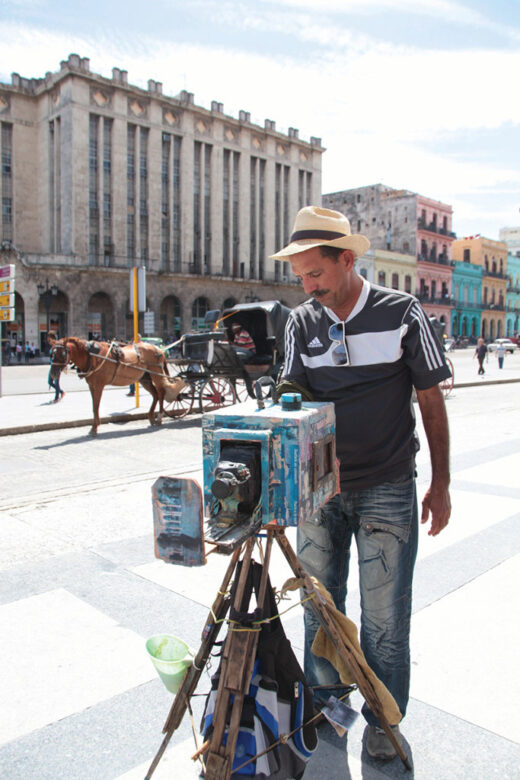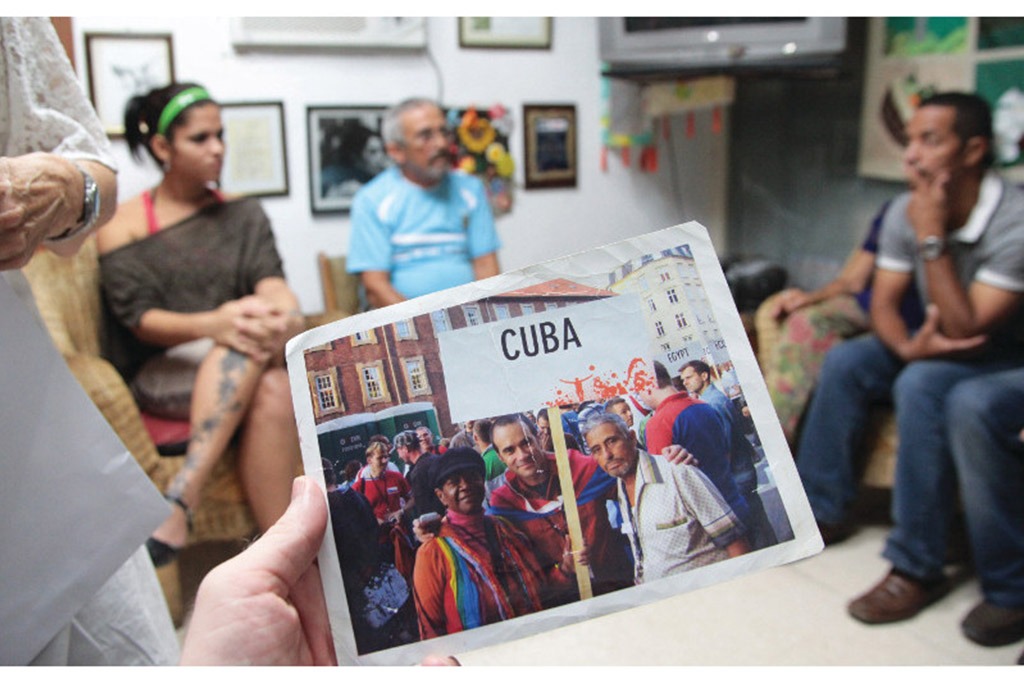In old Havana there is a tree that’s said to be older than the city itself. It was here, though it was very young, when the Taíno people would worship, venerate, and respect her as Ancient Mother. It was here too, though a little older now, in 1519 when the Spanish first established a settlement. The land was claimed, right beside her growing roots, as San Cristóbal de la Habana. She provided shade for the first mass and bestowed a breeze for the first council meeting. And as she reached toward the heavens, so did a city. Becoming resilient and strong, prosperous and wealthy, devout and ideological—she soon had a home overlooking churches and plazas, statues and mansions that rivaled those of Europe. She felt the breeze of independence and briefly felt it taken away from her. As times changed, though, she witnessed the plight of the Cuban people under a dictatorship and felt the mumblings of revolution brush through her leaves. Then, in 1959, as winter drew to an end she was here still to feel the rumbling of a tank shake her roots to usher in spring and a new hope for her land. More than half a century later, the wind again sways her branches and one of her leaves falls in 2014, twirling like a Sky Dancer, landing flatly on my head.
I am about to visit Havana, Cuba for a whirlwind three-day trip, and I decide before boarding a charter flight from Miami to José Martí International Airport, to drop the veil on my parochial American upbringing, to observe and reflect on a country that has persevered through difficult times, and embrace (not criticize) its convictions. Of course, actually being in Havana, exploring, and meeting the people, I am forced to modify this original declaration. Havana lends itself to open-minded tourists who should be curious about the political system, who want to question the state of the city, and who will dig deeper into the country’s modern-day ethos while understanding its past. And once you find yourself sharing a mojito with a local, you may be surprised to see just how open and honest they are about their lives and their country. As my journey unfolds, I find the city to be a living testament of its history and ideals, and I meet a proud people who have the strength to overcome obstacles that the modern-day traveler may not realize still exist.
I am able to visit Cuba because of loosened travel restrictions on citizens of the USA thanks to a recent change in policy encouraged by President Barack Obama. Now, tour companies are allowed to operate in the island nation as long as they are licensed through the juggernaut education-based travel program called People to People. My trip is booked through Pride World Travel, a member of the IsramWorld portfolio of brands, which is beginning their LGBT-focused tours of Cuba in 2015. Because these are educational trips, Americans are still at the mercy of the Cuban government that works to organize specific itineraries for each group. If you don’t feel like going along with the plans, too bad. As long as the official government itinerary is in play, you’re required to be with your group. But as I learn during my trip, there is a leniency depending on your guide. Luckily, my itinerary is relaxed and filled with a steady stream of good food, fascinating people from the LGBT community (including my guide), and even time to relax at the gay beach.
I highly recommend visiting through a well-established tour company like Pride World Travel. The company handled every little detail of the trip. Having all the correct documents is especially nerve-wracking for Americans visiting Cuba. The night before we depart from Miami, a representative hands me a packet with everything I need. From a formal letter granting me access and a visa to the required Cuban-issued health insurance— everything is organized. Also, I receive the VIP treatment at the Miami airport when, instead of waiting in line for the charter flight, a representative greets us, takes our bags, and hands us all the required customs forms that we’ll need to enter Cuba.
After a 45-minute flight, we land on the cracked-concrete runway of José Martí International Airport, walk off the plane onto a seemingly deserted airstrip, and are greeted by a white bust of revolutionary José Martí. Once through the doors, we are escorted into a flickering neon-lit room filled with guards. I am so glad I have the paperwork in order. The buildup and anxiety are unnecessary. The pleasant (and handsome) agent takes my whole packet, stamps my passport (though I am told you can request a separate sheet to be stamped), and I walk through the door into the baggage claim area. Only one person in my group is taken aside for further questioning (this is routine), but he rejoins us a few minutes later.

Milena and Juani Santos
Our on-the-ground tour company, Havana Tours, which is government owned, whisks us through customs and takes us straight to a van. “Welcome to Havana,” shouts our guide, Oscar, who will be with us for the entire trip. He quickly begins pointing things out, but it’s hard to pay attention. I’m in CUBA, keeps repeating in my head. CUBA! The old 1950’s American-made cars rumble by us, but they aren’t exactly like the ones in pictures. Most are beat-up, rusted, and loud, but they are still so sexy and filled with men and women cruising with the windows down.
“Here’s a school,” he says pointing to a Creamsicle-orange building with kids in white uniforms playing tetherball in the clay ground surrounded by a lush baseball field. A propaganda billboard proclaiming “We Have Socialism” with a picture of revolution leaders serves as their backdrop. “All education up to a master’s is free in Cuba,” he proudly exclaims. We all collectively shake our heads thinking of our enormous student debts.
Then, we drive past the obelisk-like monument in Plaza de la Revolución and whiz around the iconic images of Che Guevera (“Until the Everlasting Victory, Always”) and the lesser-known revolution leader Camilo Cienfuegos (“You’re Doing Fine, Fidel”).
When we exit the turnabout plaza the street becomes a gorgeous, Spanish-inspired boulevard with a tree-lined pedestrian median. Here is where I get my first glimpse of the effects of Cuba’s political and economic climate. Each side of the avenue is lined with one stately mansion after another even-more-impressive mansion. Large gates open to reveal overgrown tropical flora and gorgeous Italianate-like buildings. Each, though, has been weathered by the climate forcing their colors to fade, but their beauty, and significance can easily still be admired. “The people who lived here,” our guide half-smirks, “Weren’t too happy about the Revolution.” And you can understand why. “Oh, what the gays in New York could do to this street,” one other guest quips.
As the avenue curves toward the sea, we see our massive hotel, Meliá Cohiba Hotel Havana.

El Templete
Through the tour company, we have VIP service and are brought to “The Level,” a special check-in area with a private concierge (you’ll be able to exchange your US dollars here for the local currency, the Cuban Convertible Peso or CUC). My accommodations are unexpectedly large; it’s a corner room with surrounding windows. I open the curtains, running around my room pulling them to reveal a stunning view of the sea. A large bed, two televisions (which get international channels), a Jacuzzi tub, and most amenities one would expect, including Wi-Fi (for a hefty price), from a modern hotel. We also take delight in the multiple restaurants, the outdoor pool on the second floor, the large gym/sauna, and the attention-to-every-detail customer service.
Celebrating our first night, we literally feast at a palador (privately owned restaurant) called La Moraleja. We walk down a lighted, trellised path to an indoor/outdoor dining area. The owner happily greets us and lets us see his extensive wine collection. Importing more than a couple bottles is illegal so this assortment has taken him and his father many years to collect. Havana Tourism representatives meet us and, in a grand show, we dine on chicken, lamb, lobster, traditional rice and beans, fried yucca, clams, shrimp, and fried cheese. It’s obvious, knowing a bit about the food rationing that the socialist system in Cuba uses, that our local company doesn’t normally dine this way (of course, we don’t either). I’m hesitant to talk about it, but a fellow traveler outright asks, in a non-disrespectful way: “You’re not used to eating like this are you?”
“No!” they all say laughing. Their candid response gives us our first glimpse at the openness of the Cuban people. Our hosts freely explain the ration books and what that gives them: rice, beans, and eggs. Taking a bite out of a lobster tail one says: “It’s why we are so lucky to have been placed in tourism.” It’s a sobering moment, and we consider asking for our food to go so we can share it with others. “No, no, no,” they insist, “You can leave it for the staff at the restaurant.”
The conversation never treads on awkward, which is refreshing. We compare apartment prices, talk about their travel restrictions, the new iPhone, if they ever figured out how Whitney Houston died, and if New York is just like the movies. The owner is happy we’re visiting too. To show his appreciation, he lights us Cuban cigars and brings us beautiful rum. Taking a pull on the cigar, I think to myself: I could get used to this.
After dinner, according to our official program, we’re to meet an activist group. So I am surprised when we arrive at a nightclub named after the award-winning Cuban-produced gay movie Strawberry and Chocolate called Café Fresa y Chocolate. Inside, there is a band waiting for us called Aceituna sin Hueso. This café by day is attached to the Cuban Film Institute and is a regular hangout for the arts community (a.k.a gay), but at night, particularly once a month, the band (not exactly an activist group) performs. “It’s a place where everyone feels safe,” the bombshell lead singer Miriela Moreno tells me. By looking around, you can see many more lesbian couples than gay men sitting at the tables drinking Crystal beer. For non-Spanish speakers, Moreno’s music is still easily understood through her palpable soul-crushing passion and the get-up-and-dance beats by her band. The group, who has traveled abroad to Spain to perform, uses their lyrics to send anti-homophobia and anti-prejudice messages, she tells me. I quickly develop a straight crush on her as I gulp down several Bucanero beers while watching them completely turn the small café into a Miami Beach–style club.
A driver picks me up in the morning in a 1950’s canary-yellow, convertible Buick Dynaflow—it’s that Havana moment I’ve read about. He honks his horn to the tune of “Turkey in the Straw” as we drive down the waterfront street called the Malecón. His horn pulsing to the rhythm of the sea attracts the attention of the early-morning fishermen who turn their attention away from their poles and give us a wave. The Cuban flag proudly waves in front of a grand monument to Cuban Independence hero Antonio Maceo Grajales who sits tall on his horse looking over the city. The car breezes past the José Martí Anti-Imperialist Platform, the site of tense anti-American protests, particularly during the Elián González affair. We pass the statue of González’s father holding a small Elián and pointing to the United States Interests Section’s glass-covered building. Even while pointing it out, our guide is never awkward about US and Cuban relations.

Havana Centro Outside Capitolio
I take in my first views of the famous buildings along the Malecón. Weathered by time, the buildings seem different depending on how the early-morning sun hits them. The sun’s struggling to pierce through the dark clouds overhead, and the lighting reveals splendid patterns, architectural accents, and varying states of decay and renovation. But most of all, I think, it reveals a color spectrum that my eyes are unaccustomed to seeing in New York. It reminds me of the colors from a PAAS Easter egg coloring kit, each egg always turned out to be a new and exciting shade. The row of buildings is peppered with new projects, including a new government-owned hotel, which gives me hope that this once-grand waterfront will be revitalized.
We then turn onto an unassuming street. In accordance with our itinerary, we’re to “Visit Paloma Project which promotes gender equality (part of the Cuban Institute of Cinematographic Art and Industry and meet with the Director Lizette Vila.” A woman, no taller than 5’2″, reaches her arms out for a hug as we reach the wrought-iron arched entrance, and a lumbering dog lifts his head at the upcoming excitement. She hugs each of us like a long-lost relative and leads us through the well-manicured front garden and into the building. Trinkets (witches, clocks, sage, figurines) and old photos (Castro, trans* activists, famous singers) dot the walls, and we carefully try not to disturb the large Santaria (local religion) shrine on the floor that’s filled with hopes, dreams, and prayers. We’re brought into a small room and offered tea and cookies, and we kindly accept (it is considered bad form not to enjoy specially prepared food).
One by one, new people enter and sit with us in a tiny windowless room. We form a circle and exchange those awkward first-meeting smiles. Lizette Vila enters the room and goes around introducing everyone. “This is Milena and Juani Santos,” she says pointing to an older gentleman and a young lady. “Juani is the first transgender person in Cuba, and Milena has recently transitioned and is the focus of an upcoming documentary,” she nonchalantly shares as our jaws nearly hit the floor.
She then continues and introduces Isabel Blanco, a famous ballerina who now teaches acceptance and empowerment through dance; Ingrid Leon, who produces documentaries about woman’s rights and has just completed the documentary about Milena; and Teresa de Jesús Fernández who works for the government’s gay-rights agency, Cenesex.
For a gay journalist, this room is a jackpot. I am ready to fire off question after question, but it never becomes a structured interview, it becomes a wonderful discussion that doesn’t lend itself to an uncomfortable middle-of-the-room recorder. We drop formalities, and we talk, connecting with each other, undistracted like pre-iPhone days. We learn of Juani’s struggles growing up as the only girl among boys and how he has found acceptance from his brothers after having pioneering surgery in Copenhagen. Milena tells us about being kicked out of her home and finding the government-supported resources and government-provided medical treatments to make her into the woman that she always knew she was. Ingrid discusses the difficulties of creating documentaries in Cuba and the thrill of watching her controversial pieces air on the state-run television channel and her hopes to show them at international festivals.
It is Lizette Vila, whose passion for her work, her openness, and her intelligence that captivates my attention most. Moving her hands with wild gesticulations, reminding me of my Italian grandmother, she discusses each person in the room’s successes and troubles. Her empathy and her understanding go far beyond the goal of the organization, which is to advance equality through the arts. While her ideas on feminism and the LGBT community seem quite progressive, even radical, she insists that they are in line with the beliefs of many other people in the country, including Mariela Castro, the director of Cinesex, and the daughter of President Raúl Castro.
She likens Cuba to a strong, fertile, and beautiful woman whose resilience in the face of revolution and embargoes continues to inspire her and the arts community. And while she is lucky to travel around the globe and meet with LGBT and feminist leaders, she continues to thank socialism. “It’s because of socialism and the Cuban government that we exist,” she tells us while placing her arm on my shoulder.
After long hugs and countless photos, our driver and Oscar have to nearly pull us away, despite the excitement of our next stop, the gay beach.


